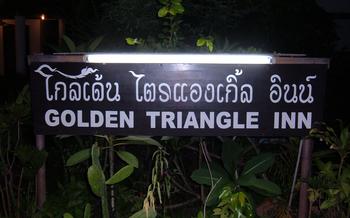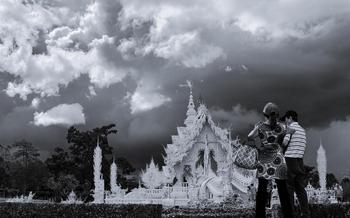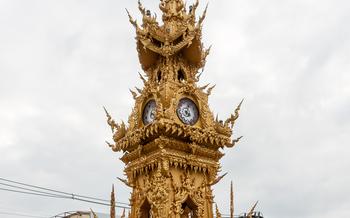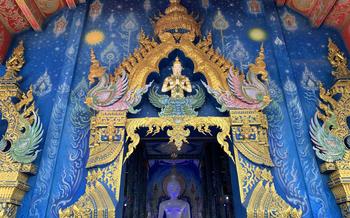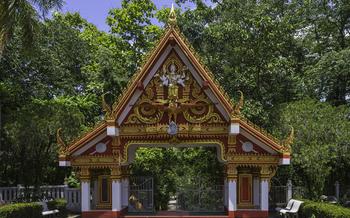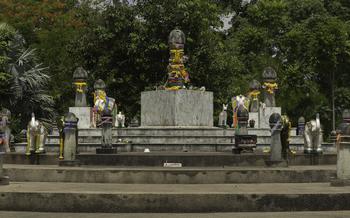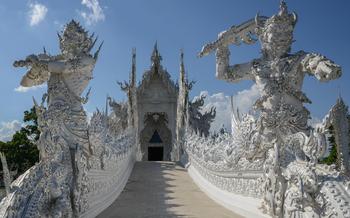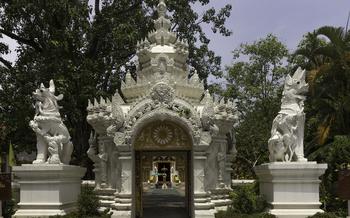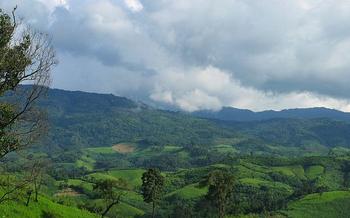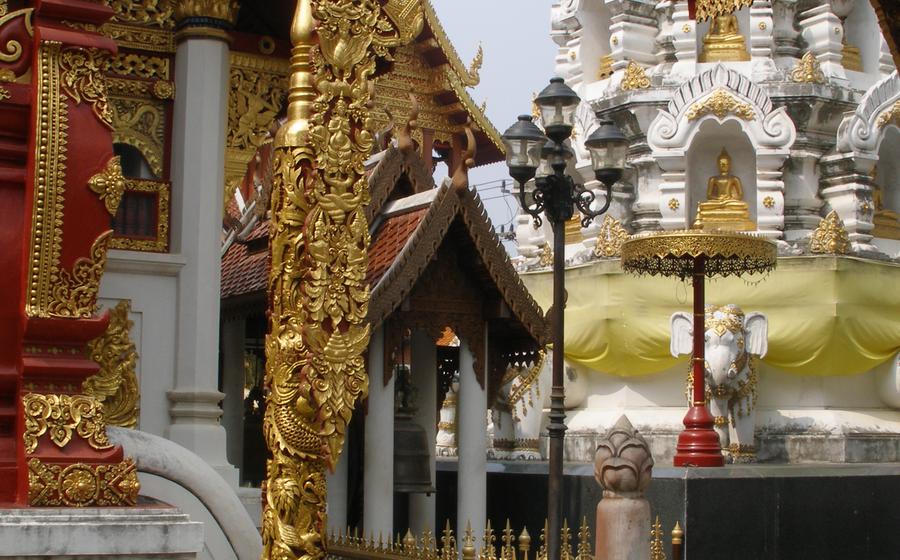
Chiang Rai Walking Street (Saturday Walking Street)
- History and Origins of Chiang Rai Walking Street
- Location and Accessibility
- Opening Hours and Frequency
- Cultural Significance and Local Traditions
- Etiquette and Respectful Behavior
- Food and Beverage Stalls
- Handicrafts and Souvenirs
- Street Performances and Entertainment
- Shopping for Clothing and Accessories
- Art Galleries and Exhibitions
- Temples and Religious Sites
- Family-Friendly Activities
- Nightlife and Bars
- Photography Opportunities
- Sustainable Tourism Practices
- Insider Tip: Unveiling the Hidden Gems of Chiang Rai Walking Street
History and Origins of Chiang Rai Walking Street
Chiang Rai, nestled in the northernmost region of Thailand, boasts a rich history dating back to the 13th century when it served as the capital of the Lanna Kingdom. The city's cultural heritage is deeply intertwined with its vibrant street markets, and the Chiang Rai Walking Street is a testament to this legacy.
The concept of a walking street, where roads are temporarily closed to traffic and transformed into pedestrian-only zones, originated in Thailand as a way to promote local culture and economy. These markets often coincide with specific days of the week, holding significant cultural or religious importance.
In Chiang Rai, Saturday holds special significance as it is considered an auspicious day for starting new ventures and making important decisions. Thus, the Chiang Rai Walking Street, also known as Saturday Walking Street, was established to harness this positive energy and provide a platform for local vendors to showcase their products and talents.
Over the years, the walking street has evolved into a beloved tradition, attracting both locals and tourists alike. It has become an integral part of Chiang Rai's cultural identity, preserving local customs and traditions while also embracing modern trends and influences.
Location and Accessibility
The bustling Chiang Rai Walking Street finds its home in the heart of the city, along Thanalai Road. Its strategic location, a stone's throw away from the iconic Clock Tower, makes it easily accessible by foot or local transportation. A short stroll from the Chiang Rai Night Bazaar, the walking street offers a seamless transition from daytime shopping to vibrant evening explorations.
To delve into the vibrant atmosphere of the walking street, visitors can opt for the convenient public transportation options available. Songthaews, the ubiquitous red pickup trucks that double as shared taxis, make frequent rounds and can be hailed along the main roads. Alternatively, tuk-tuks, with their distinctive motorized three-wheeled design, offer a more personalized and adventurous ride to the market.
For those who prefer a scenic approach, renting a bicycle is an excellent way to explore the city's charms en route to the walking street. Numerous bike rental shops are scattered around Chiang Rai, allowing visitors to pedal at their own pace and soak in the sights and sounds of the city.
Once at the walking street, the best way to navigate its labyrinthine alleys and bustling stalls is on foot. The narrow lanes offer a unique charm, inviting visitors to meander through the throngs of locals and fellow travelers, discovering hidden gems and savoring the vibrant atmosphere.
Ample parking facilities are available in the vicinity of the walking street to accommodate visitors arriving by private vehicles. The Chiang Rai Bus Terminal, situated a short distance away, provides convenient access for those arriving by bus from neighboring cities and regions.
Opening Hours and Frequency
The Chiang Rai Walking Street operates strictly on Saturdays, from 5 PM to 11 PM. This weekly event ensures that locals and tourists alike can plan their visit accordingly. Throughout the year, the market remains consistent with its schedule, except for special occasions or public holidays, which may affect its operation. Visitors are advised to check local sources or official tourism websites for any changes or updates to the market's hours.
To fully immerse oneself in the vibrant atmosphere of the walking street, it is recommended to visit during the evening hours, when the majority of vendors and performers are present. Whether you prefer the beginning of the night to avoid crowds or the later hours for a more lively experience, the Chiang Rai Walking Street offers a unique and authentic cultural immersion every Saturday.
Cultural Significance and Local Traditions
Walking streets hold a significant place in Thai culture, serving as vibrant community spaces where locals and tourists come together to socialize, shop, and savor delicious street food. Chiang Rai Walking Street is no exception, embodying the essence of Thai traditions and customs.
During the market, visitors can witness locals adorned in traditional Thai attire, showcasing their cultural pride. The air is filled with the harmonious sounds of live music and the cheerful chatter of vendors and patrons. Respectful behavior is highly valued, and visitors are encouraged to dress modestly and refrain from causing any disruption to the peaceful ambiance.
Etiquette and Respectful Behavior
To ensure a harmonious and enjoyable experience for all, visitors are advised to follow certain etiquette guidelines while exploring Chiang Rai Walking Street. When interacting with locals, a polite greeting and a genuine smile go a long way. Refrain from touching or pointing at people or objects, as this is considered disrespectful.
When visiting temples or religious sites located near the walking street, visitors should dress appropriately, covering their shoulders and knees. Removing shoes before entering a temple is a customary practice, and visitors should maintain a respectful silence while inside. These simple gestures demonstrate respect for local customs and help preserve the sacredness of these religious spaces.
Food and Beverage Stalls
Chiang Rai Walking Street is a culinary haven, where the air is filled with mouthwatering aromas and the sight of sizzling grills and steaming pots draws in hungry visitors. From traditional Thai street food to international delicacies, there's something to satisfy every palate.
Don't miss the chance to sample the famous khao soi, a rich and flavorful curry noodle soup that is a specialty of northern Thailand. Other must-try dishes include sai ua, a spicy sausage made with pork, lemongrass, and kaffir lime leaves, and khanom jeen nam ngiao, a fermented rice noodle dish served with a variety of curries and condiments.
For those with a sweet tooth, there are plenty of options to choose from. Indulge in khao niew mamuang, sticky rice with sweet mango, or khanom buang, crispy crepe-like pastries filled with sweet coconut custard.
For vegetarians and vegans, there are several stalls offering delicious meat-free options, such as pad thai, a stir-fried noodle dish with tofu and vegetables, and khao pad sapparot, fried rice with pineapple and cashew nuts.
Navigating the food stalls is easy, as most vendors display their menus with pictures and prices. Communication can be a bit challenging, but pointing and smiling usually does the trick. Cash is the preferred method of payment, so be sure to have some on hand.
Handicrafts and Souvenirs
Chiang Rai Walking Street is a haven for those seeking unique handicrafts and souvenirs to cherish or gift. Local artisans showcase their skills, creating exquisite handmade products that reflect the region's rich cultural heritage. From intricate silver jewelry and hand-woven textiles to intricately carved wooden sculptures and colorful ceramics, there's something for every taste and budget.
One must-buy souvenir is the delicate Sa paper products, renowned for their durability and intricate designs. Handcrafted from mulberry tree bark, these papers are transformed into beautiful umbrellas, notebooks, and other decorative items.
For those seeking a touch of spirituality, the walking street offers a variety of Buddha images and amulets, believed to bring good luck and protection. These sacred objects are meticulously crafted by skilled artisans, ensuring each piece is unique and holds deep cultural significance.
Bargaining is an integral part of the shopping experience in Chiang Rai. While prices are generally reasonable, don't hesitate to engage in friendly negotiations with the vendors. This not only allows you to score a good deal but also supports the local economy and fosters meaningful interactions with the artisans.
Remember, your purchases at the walking street directly contribute to the livelihood of local communities. By supporting these talented artisans, you help preserve and promote Thailand's rich cultural heritage while taking home a piece of Chiang Rai's unique charm.
Street Performances and Entertainment
The Chiang Rai Walking Street comes alive with vibrant street performances and cultural entertainment. Every evening, talented local artists take to the stage to showcase their skills and captivate audiences. From live music and traditional dance to comedy acts and fire shows, there's something for everyone to enjoy.
The performances are usually held at designated stages along the walking street, creating a lively and energetic atmosphere. Visitors can stroll from one stage to another, immersing themselves in the diverse talents of Chiang Rai's performers.
Engaging with the local performers is a great way to connect with the culture and appreciate their passion for the arts. Don't be afraid to show your support by clapping, cheering, or even joining in on the fun.
To capture memorable moments, make sure to bring your camera and take plenty of photos or videos. Just be respectful of the performers and ask for permission before taking their pictures.
Shopping for Clothing and Accessories
Chiang Rai Walking Street is a shopper's paradise, offering a wide variety of affordable fashion items, clothing, and accessories. From trendy t-shirts and skirts to stylish bags and jewelry, you're sure to find something to suit your taste and budget. The latest trends and styles are showcased here, making it a great place to update your wardrobe or find unique pieces that you won't find anywhere else.
To find the best deals, be sure to bargain effectively with the vendors. Don't be afraid to ask for a lower price or offer to buy multiple items for a discount. It's also important to support local designers and artisans by purchasing their handmade products. This helps to preserve traditional crafts and skills while also contributing to the local economy.
For a more sustainable shopping experience, consider opting for items made from eco-friendly materials or produced by local artisans who use traditional techniques. This helps to reduce the environmental impact of your purchases and supports local communities.
Art Galleries and Exhibitions
The Chiang Rai Walking Street is home to several art galleries and exhibitions that showcase the works of talented local artists. These galleries provide a platform for artists to display their paintings, sculptures, crafts, and other forms of artwork. Visitors can admire the unique creations, learn about the inspiration behind each piece, and even purchase artwork as a special souvenir from their trip.
Attending art exhibitions at the walking street is a great way to immerse yourself in the local art scene and appreciate the diverse talents of Chiang Rai's artists. You can engage in conversations with the artists, understand their creative process, and gain insights into the local culture and heritage.
To make the most of your art gallery experience, take your time to explore each exhibit, read the descriptions, and ask questions to the artists if they are present. Support local artists by purchasing their artwork, which not only contributes to their livelihood but also helps preserve the vibrant art culture of Chiang Rai.
Temples and Religious Sites
Chiang Rai is renowned for its rich cultural heritage and religious significance. In proximity to the vibrant Chiang Rai Walking Street, you'll find several historical temples and shrines that offer a serene contrast to the lively market atmosphere. These sacred sites provide an opportunity to delve deeper into the spiritual side of Thailand and appreciate the country's deep-rooted Buddhist traditions.
Among the must-visit temples is Wat Phra Kaew, which houses the revered Emerald Buddha, a highly sacred Buddha image carved from a single piece of jade. The temple's intricate architecture and stunning murals depict scenes from Buddhist mythology and Thai history.
Another notable temple is Wat Rong Khun, also known as the White Temple, which is an architectural masterpiece adorned with intricate carvings, mirrored mosaics, and gleaming white facades. The temple's unique and contemporary design is a testament to the artistic vision of its creator, Chalermchai Kositpipat.
When visiting these temples, it's important to observe respectful behavior and dress code. Visitors should dress modestly, covering their shoulders and knees, and remove their shoes before entering the temple grounds. It's also customary to maintain silence and refrain from pointing at Buddha images.
By combining cultural exploration with religious experiences, visitors can gain a deeper understanding of the spiritual essence of Chiang Rai and Thailand as a whole. These temples offer a tranquil respite from the bustling market, allowing visitors to reflect and appreciate the country's rich heritage.
Family-Friendly Activities
Chiang Rai Walking Street offers a range of kid-friendly attractions and activities to ensure a fun and memorable experience for families. From exciting games and rides to captivating entertainment, there's something for children of all ages to enjoy.
Parents can let their little ones loose in the designated play areas, where they can engage in fun games, bounce on inflatable castles, and participate in interactive activities. Thrilling rides, such as mini roller coasters and carousels, provide an extra dose of excitement for adventurous kids.
Throughout the walking street, talented performers showcase captivating shows that appeal to both children and adults. Traditional Thai dance performances, puppet shows, and magic tricks are just a few examples of the entertainment on offer. These shows offer a glimpse into Thai culture while keeping kids engaged and entertained.
To ensure a safe and supervised environment for families, the walking street is well-lit and patrolled by security personnel. Parents can relax and enjoy the market's offerings while their children explore and have fun under watchful eyes.
Here's a tip for parents: plan your visit to coincide with the early evening hours, when the crowds are smaller and the temperatures are more pleasant for kids. This will allow your family to enjoy the walking street's attractions without feeling overwhelmed or rushed.
Nightlife and Bars
As the sun sets and the sky transforms into a canvas of vibrant hues, Chiang Rai Walking Street transforms into a bustling hub of nightlife and entertainment. The air crackles with energy as locals and tourists alike spill out of atmospheric bars, their laughter and chatter blending with the infectious rhythm of live music.
The street pulses with an array of bars catering to diverse tastes. Whether you're seeking a laid-back ambiance with acoustic melodies or a lively dance floor with energetic beats, you'll find your haven here. Local musicians showcase their talents, captivating audiences with soulful renditions of Thai and international hits.
Grab a refreshing cocktail or a local beer and let the music wash over you, transporting you to a realm of pure bliss. Mingle with friendly locals, share stories, and make connections that will last a lifetime.
Remember to imbibe responsibly and stay mindful of your surroundings. The vibrant energy of Chiang Rai Walking Street's nightlife is an experience not to be missed, leaving you with unforgettable memories of a night well spent.
Photography Opportunities
The Chiang Rai Walking Street is a visual feast, offering countless opportunities to capture stunning photographs. The vibrant colors of the street food stalls, the intricate designs of the handmade crafts, and the smiling faces of the locals create a picturesque backdrop. As the sun sets, the street comes alive with twinkling lights, adding a magical touch to the atmosphere.
Whether you're a professional photographer or simply an enthusiastic traveler, you'll find plenty of Instagrammable spots along the walking street. Capture the essence of Thai culture by photographing the traditional dancers in their colorful costumes, the street musicians performing lively tunes, or the locals engaged in their daily activities. Don't miss the chance to take a panoramic shot of the entire street, showcasing the vibrant energy and diversity of this unique market.
Remember to be respectful when taking photos of people, especially when they are engaged in religious or cultural activities. Ask for permission before taking someone's photo, and always be mindful of their privacy. By capturing the beauty of the Chiang Rai Walking Street through your lens, you can share the wonders of this cultural gem with the world while preserving memories that will last a lifetime.
Sustainable Tourism Practices
The Chiang Rai Walking Street embraces sustainable tourism practices to minimize its environmental impact and preserve its cultural heritage. Visitors are encouraged to adopt eco-friendly habits while exploring the market. Plastic bags and single-use plastics are discouraged, and biodegradable alternatives are widely available. Many food vendors use reusable or compostable tableware, reducing waste generation.
Supporting local businesses that prioritize sustainability is crucial. Look for vendors using locally sourced ingredients, recycled materials, or renewable energy sources. By choosing these businesses, you contribute to the local economy while promoting responsible tourism.
As a traveler, you can contribute to sustainability by bringing your own reusable shopping bags, water bottles, and utensils. Avoid buying souvenirs made from endangered species or materials harmful to the environment. Respect the local culture and traditions, and dispose of waste properly in designated bins.
Together, we can ensure that the Chiang Rai Walking Street remains a vibrant and sustainable cultural attraction for generations to come.
Insider Tip: Unveiling the Hidden Gems of Chiang Rai Walking Street
Venture beyond the main street: Explore the smaller alleys and side streets to discover hidden food stalls and unique souvenirs.
Join a local cooking class: Learn to prepare traditional Thai dishes from local experts, gaining insights into culinary secrets.
Visit the clock tower: Admire the architectural beauty of the iconic clock tower, a symbol of Chiang Rai's rich history.
Attend a traditional Thai massage: Indulge in a rejuvenating massage, experiencing the ancient healing techniques of Thailand.
Explore the night market: Discover a vibrant night market with live music, street performances, and a diverse array of food and beverages.

